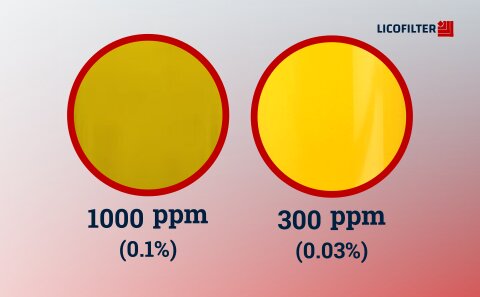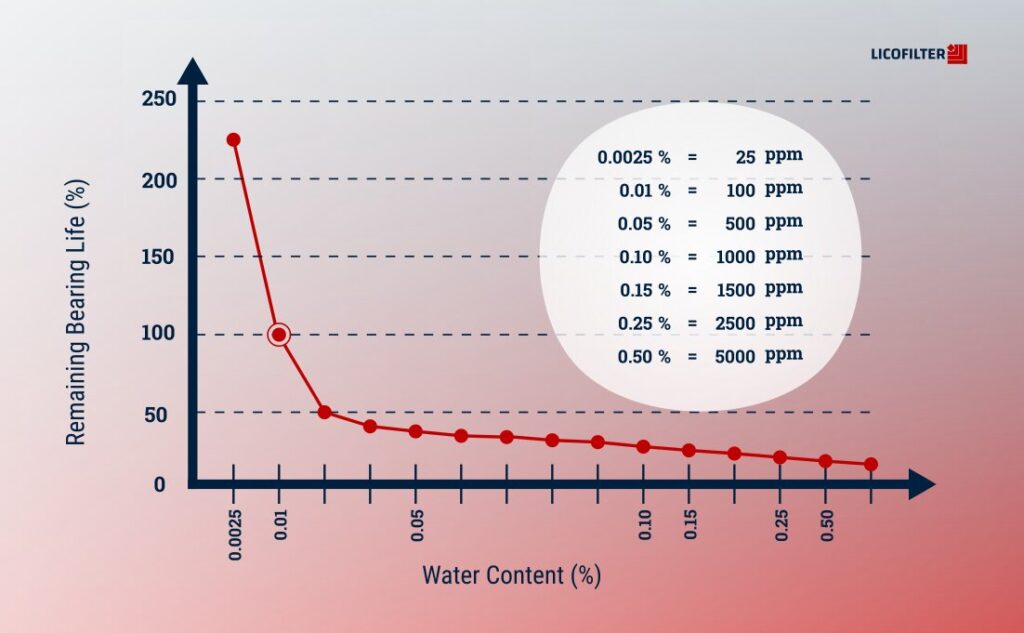This is the fourth part of a ten-part series on Hydraulics and Filtration, a general guide on hydraulic filtration systems. The third and fourth part review the main types and sources of contamination in hydraulic systems. The previous part discussed solid particles as the most important contaminants. This part will extend the discussion with water and air as other common contaminants.
Water
The hydraulic fluid normally contains 100ppm to 300ppm of dissolved water while keeping its color and clear appearance. More water content will make the fluid look cloudy and opaque.

Different fluids need different percentages of water content to reach their saturation point. This is shown in the following table:
Water saturation points in common fluids
| Fluid type | Water content (ppm) | Water content (%) |
| Hydraulic Fluid | 300 | 0.03 |
| Lubricant | 400 | 0.04 |
| Transformer Oil | 50 | 0.005 |
Damages
With the water content passing the saturation point in a fluid, its physical and chemical properties are altered. This can cause serious damage to the system, including:
- Corrosion of metal surfaces
- Increased abrasive wear
- Bearing fatigue
- Chemical decomposition of additives
- Fluid viscosity change
- Increased electrical conductivity
The presence of water can cause the lubricating film to become thinner and thus increase abrasion, especially in the presence of metals such as copper. Moreover, as the additives decline, corrosion of metal surfaces increase. The accelerated oxidation can lead to the formation of acidic sludge in the system and decrease the filtration efficiency. In transformer oils, excessive water content can increase electrical conductivity and thus increase the risks of electricity-related accidents. Therefore, it is crucial to carefully control the amount of water in hydraulic fluids.

The graph above shows the estimated bearing life based on the presence of 100ppm water in the fluid. With more water content, bearing life is shortened and halved around the saturation point.
Damage Prevention
The following actions can be effective in preventing water from entering a system:
- Proper Storage
- Elimination of any leak in thermal converters
- Elimination of any leak in the reservoir inlet
- Replacing damaged seals
While these measures can prevent and reduce water ingression to some extent, water can always infiltrate systems or be produced through condensation inside reservoirs. In order to keep the water content at an acceptable level, there are three methods which are effective in separating water from the fluid:
- Use of water-absorbing filters (water separators)
- Spinning method (centrifugation)
- Use of vacuum dehydrators
Water is found in colloidal form in oils. This is the physical quality exploited by the methods above for separating water from hydraulic fluids. Water-separating filters are usually made of micro-fiberglass media. The special synthetic non-woven structure of these media separates water colloids from the fluid by absorbing them. The centrifugal method separates water particles by pushing them away from the fluid body in a spinning motion. The most effective and complete method, however, is vacuum dehydration, which vaporizes and separates water by creating a negative pressure on the fluid surface. Vacuum dehydration systems can be used as complementary measures in hydraulic systems.
Air
The presence of air bubbles in the hydraulic fluid can disrupt the system and cause its efficiency to decrease considerably. This disruption can interfere with force transmission through the fluid. Damage caused by air entering hydraulic systems include:
- Cavitation
- Foaming
- Increased temperature
- Accelerated oxidation
- Reduced pump capacity
- Chemical reactions
- Less effective lubrication
In order to eliminate the destructive effects of air on hydraulic systems, it must be prevented from entering these systems in the first place. Methods for achieving this include:
- Providing proper head for the pump
- Opening and closing control valves slowly
- Ensuring the functionality of the reservoir cap
- Sealing all entrances to the system
As mentioned before, preventing contaminants from entering hydraulic systems is crucial and should be taken very seriously. As contaminants, water and air can reduce a system’s performance heavily. Therefore, these contaminants must be taken care of, just as with solid particles.
